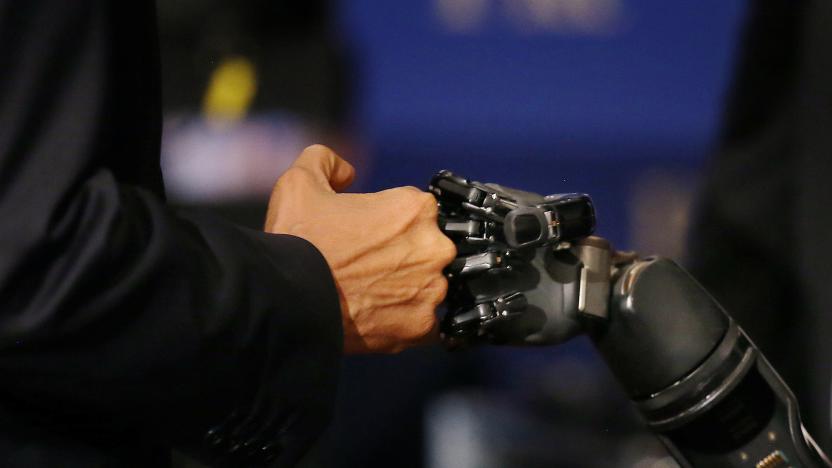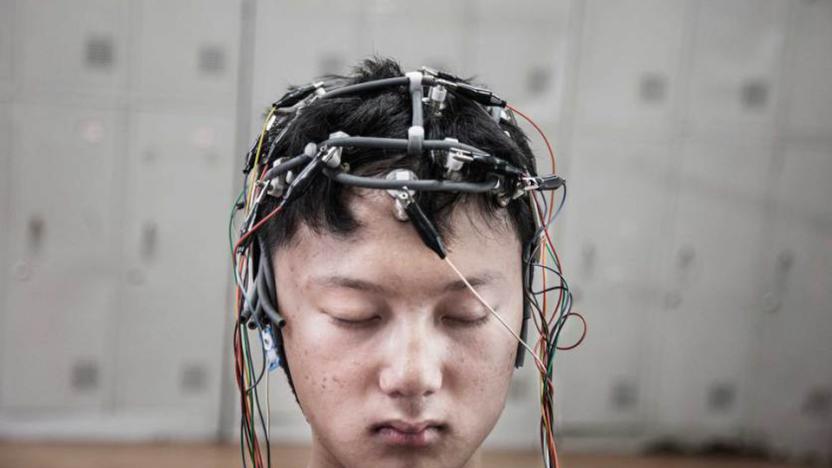neural
Latest

Researchers boost robotic arm movement by adding a sense of touch
Researchers helped a paralyzed man to move his robotic arm even faster by adding tactile feedback to the process.

MIT fit tens of thousands of artificial brain synapses on a single chip
MIT engineers put tens of thousands of artificial brain synapses on a single chip that's smaller than a piece of confetti.

New prosthetic legs let amputees feel their foot and knee in real-time
There's been a lot of research into how to give robots and prosthesis wearers a sense of touch, but it has focused largely on the hands. Now, researchers led by ETH Zurich want to restore sensory feedback for leg amputees, too. In a paper published in Nature Medicine today, the team describes how they modified an off-the-shelf prosthetic leg with sensors and electrodes to give wearers a sense of knee movement and feedback from the sole of the foot on the ground. While their initial sample size was small -- just two users -- the results are promising.

Neural implants and robot arms allow paralyzed man to feel again
After breaking his neck more than a decade ago, Nathan Copeland has finally regained his sense of touch. The only catch is that those feeling are fake -- artificially generated by a robotic arm and an array of tiny electrodes embedded in his brain by researchers at the University of Pittsburgh Medical Center.

Dogs understand what you're saying, not just the sound of your voice
One pinnacle of human development has been the ability to comprehend language, thought to be a major achievement separating us from the animals. So it was assumed with dogs, but new research reveals that canines understand more subtleties in speech than we thought thanks to similarities in brain regions to those of humans.

10 ways to manage the post-Thanksgiving madness
Ahhh, the holidays. What a lovely time of year to catch up with the extended family and do a quick bit of shopping at enormous discounts. The truth of the situation, however, is often less relaxing than it sounds. Family get-togethers can be taxing, especially when you factor in the state of politics today and the obligatory "drunk uncle." Black Friday (which apparently starts on Thursday now) has become a frantic shopping battle, with everyday folks emboldened by insanely low-priced waffle makers. That's OK, technology is here to help you regain your inner zen. Breathe deeply, try to find a quiet corner and join us in the gallery below for some helpful gadgets to bring you serenity when you need it most: Now!

I electroshocked my brain and I feel great!
For years I've relied on caffeine and cannabis to modulate my moods. It's an effective, albeit slightly illegal, system and not without its side effects. Too much coffee and I become a jittery, hyperactive mess. Too much cannabis and I spend the next few hours taking a weed nap. But that's where the Thync comes in. It's a tiny, head-mounted device that is supposed to discretely modulate your moods by gently zapping your brain with pulses of electricity. But can the power of Tesla really get me out of an emotional funk the way a doppio espresso and some dab rips can?

Brain implants help the paralyzed type faster
It's possible for paralysis victims to type and otherwise communicate with the world, but they usually have to do so at a glacial pace. They might not be nearly so limited in the future, though. In experiments combining BrainGate2 (a high-speed neural implant system) with text entry software, researchers had a Lou Gehrig's sufferer type words at six words per minute. While that may not sound quick on the surface, it's incredibly fast for someone relying solely on mental activity to write a message.

Flexible fiber implants treat your brain without hurting it
Brain implants are limited right now -- they typically measure just one thing at a time, and their stiff wiring can wreck tissue if the device stays in place for long enough. Neither of those problems will matter if MIT's flexible fiber implant becomes a practical reality, though. The school's researchers have developed very thin (almost nanoscale), flexible polymer fibers that have customizable channels for carrying chemicals, electricity and light. These strands could not only treat a patient with drugs and light stimulation, but measure the response with electrodes; you'd know whether or not your medicine is working. The bendy, unintrusive design should also be safe for your body, making it possible to tackle long-term illnesses.

The Big Picture: Monitoring the brains of online game addicts
Online game addiction is a real problem, and some countries are willing to take drastic measures to get these players living a healthier lifestyle. Need proof? Just look up. Photographer Fernando Moleres recently visited an internet gaming rehab camp in Beijing, and saw the facility monitoring the brain activity of addicts using the elaborate device you see above -- the camp wants to see that your mind is changing. The facility also relies on a mixture of medicine, military social structure and psychotherapy to set patients straight. It's hard to know if these "tough love" measures are truly effective, but their very existence reveals just how widespread compulsive gaming has become.

Atom-scale brain sensors will show exactly how your mind works
Neural activity maps frequently present an incomplete picture of how a brain works; you can measure electrical activity, stimulate it or visualize the anatomy, but you can't do all three. DARPA and the University of Wisconsin might just pull off that seemingly impossible feat, however. They recently built a hybrid brain sensor that combines both electrical and optical techniques to present a vivid picture of what's happening inside the mind. The sensor is primarily made of ultra-thin graphene (just four atoms thick) that both conducts electricity and lets light through. By putting this device on top of neural tissue, you can simultaneously create brain activity and monitor virtually every aspect of it. Graphene is safe for your body, too, so you shouldn't face the same risks you see with metal alloys.

Google uses self-aware datacenters to cut the cost of searching
Google spits out about 4 million search results per minute (among many other duties), which consumes a lot of energy. According to a recent blog, it cut its electrical bills significantly by applying the same kind of machine learning used in speech recognition and other consumer applications. A data center engineer on a 20 percent project plotted environmental factors like outside air temperature, IT load and other server-related factors. He then developed a neural network that could see the "underlying story" in the data, predicting loads 99.6 percent of the time. With a bit more work, Mountain View managed to eke out significant savings by varying cooling and other factors. It also published a white paper to share the info with other data centers and prove once again that humans are redundant.

Research team restores monkey's hand function with artificial neural connection
Scientists working together from Japanese and American universities may have made a pretty large leap in restoring neural function for those with non-paralyzing spinal cord injuries. The researchers applied a "novel artificial neuron connection" over lesions in the spinal cord of a partially paralyzed monkey, partially restoring its arm / brain circuit and allowing greater hand control purely by brainpower. The team also created a reverse circuit where muscle activity from the arm stimulated the spinal cord, reinforcing the signals and "boosting ongoing activity in the muscle." There's no word on whether it would help those with full paralysis, though for lesser "paretic" damage, "this might even have a better chance of becoming a real prosthetic treatment rather than the sort of robotic devices that have been developed recently," according to the team. See the source and More Coverage links for more.

Intel designs neuromorphic chip concept, our android clones are one step closer
Most neurochip projects have been designed around melding the brain and technology in the most literal sense. Intel's Circuit Research Laboratory, however, is betting that we might get along just fine with neuromorphic (brain-like) computers. By using valves that only have to respond to the spin of an electron, as well as memristors that work as very efficient permanent storage, the researchers believe they have a design that operates on the same spikes of energy that our noggins use rather than a non-stop stream. Along with simply using power levels closer to those of our brains, the technique allows for the very subtle, massively parallel computations that our minds manage every day but which are still difficult to reproduce with traditional PCs. There's still a long path to take before we're reproducing Prometheus' David (if we want to), but we've at least started walking in the right direction.

Inhabitat's Week in Green: solar supertrees, pee-powered plasma and a bug-eyed mantis shrimp with a serious right hook
Each week our friends at Inhabitat recap the week's most interesting green developments and clean tech news for us -- it's the Week in Green. It's been a big week for energy-efficient breakthroughs in the scientific community. Scientists at MIT developed a new type of textured nano surface that could reduce the thickness of silicon used in solar panels by more than 90 percent, bringing down the cost of photovoltaic technology. Meanwhile, in the land down under, researchers at the Australian National University are working on a pee-powered plasma thruster that could make deep space missions more feasible. Also this week, a team of engineers from MIT developed a new glucose fuel cell that runs on the same sugar that powers the human body and could be used for brain implants.

IBM says mind control next big thing in human-computer interaction; GLaDOS offers cake reward
From the ongoing Google-Apple turf war on voice recognition to Microsoft's gesture tracking with Kinect, humans continue to push the envelope on how to interact with computers and devices. Now IBM says mind control will be the next field to see a big leap, predicting breakthroughs within the next five years. Keep in mind that they're not talking about controlling humans a la Gorilla Grodd ... yet. Instead, they're talking about controlling computer actions and devices via brain waves. IBM software guru and potential Borg recruit Kevin Brown (pictured right) has already been using a headset to move cubes on a computer screen at will. Given the ongoing progress with mind-controlled cars and BrainGate, IBM's prediction might not be too far-fetched.

Researchers take one step closer to neural-controlled bionic legs for safer mobility
We've seen our fair share of prosthetic arms and computer interfaces operated with little more than the firing of a synapse, but legs? They're a different story: balancing and propelling a sack of (mostly) flesh and bone is a much more complicated task than simply picking up a sandwich. Thankfully, the Rehabilitation Institute of Chicago's Center for Bionic Medicine is now one step closer to thought-controlled lower-limb prosthetics. As pictured here, the researchers' early simulations showed that amputees could control a virtual knee and ankle with 91-percent accuracy, by way of pattern recognition software to interpret electrical signals delivered through nine different muscles in the thigh -- patients think about moving, thus lighting up the nerves in varying patterns to indicate different motions. The ultimate goal is to hook up bionic legs through the same way, which would offer a greater range of motion than existing prosthetics, making tasks like walking up and down stairs safer. Now all we need is a quadruple amputee willing to pick up a badge and slap on an eye-tracking microdisplay.

BrainGate hits 1,000 day mind-control milestone, nearly three years of pointing and clicking
Aspiring Svengalis rejoice! For BrainGate has reached a significant landmark in computational thought-control -- the 4 x 4-mm implantable chip has given a woman with tetraplegia the ability to point and click with her brain for 1,000 days. An article recently published in the Journal of Neural Engineering said the woman, known simply as S3, performed two easy tasks every 24 hours, using her mind to manipulate a cursor with 90 percent accuracy. Each day she was monitored, S3 would post up in front of a computer and continuously command the thing with her thoughts for 10 minutes. Functionality reportedly deteriorated over time, but the paper points to the chip's durability, not sensor-brain incompatibility, as the culprit. Research is currently underway to incorporate BrainGate into advanced prosthetics that could get tetraplegics like S3 up and moving again. Now, how's that for the power of positive thinking?

NeuroFocus makes first wireless EEG sensor headset, don't call it a thinking cap
It's well known that advertisers track our web-surfing habits to tailor the ads we see, but they'd prefer to know exactly what's going on inside of that brain of yours. NeuroFocus' aptly named Mynd, a full-brain wireless EEG sensor headset, serves as a stylish and easy way to record your thoughts whilst gazing at logos and lusting after products. In addition to neuromarketing applications, the European Tools for Brain-Computer Interaction consortium (TOBI) see it as a tool to help develop new technology for those with neurological disabilities. Sporting looks straight off the Game Grid, the Mynd is made of medical-grade EEG sensors to capture brain activity 2,000 times per second and a Bluetooth radio to shoot your thoughts to the smartphone, tablet, or PC of your choice. The wireless bit represents a huge upgrade over traditional EEG caps because it makes the headset's mind-reading powers available in shopping malls and living rooms instead of just hospitals. All so the sellers of things can know just how effective a spokesperson the ETrade baby really is. PR's after the break.

DARPA-funded prosthetic arm reaches phase three, would-be cyborgs celebrate
Last we heard from Johns Hopkins University's Applied Physics Laboratory, it wanted a neurally-controlled bionic arm by 2009. Needless to say, the school overshot that goal by a tiny bit, and have now been beaten (twice) to the punch. But DARPA sees $34.5 million worth of promise in their third and final prototype, which will enable the nine pound kit (with 22 degrees of freedom and sensory feedback) to begin clinical trials. Rechristened the Modular Prosthetic Limb, it will be grafted onto as many as five real, live persons, the first within the year. Using the targeted muscle reinnervation technique pioneered at the Rehabilitation Institute of Chicago, patients will control these arms directly with their thoughts, and for their sakes and the fate of humanity, hopefully not the other way around. Press release after the break.










